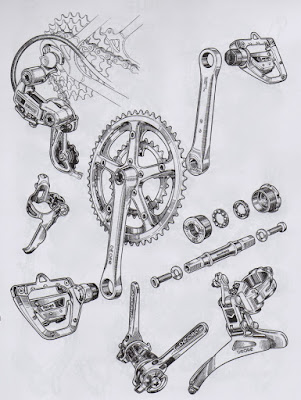Today I will start with a quiz.
Take a look at this bike:
Now check out this:
What do they have in common?
Now, if you know anything about either of these bikes, you might think it's absolute heresy to posit that they might share any trait besides two wheels. The first machine, a Schwinn Clairmont, can be purchased in Wal-Mart and other fine stores. ;-)
The second, on the other hand, is a Silkroad from Tout Terrain. Somehow I don't expect to see it parked on a street near me, or anywhere else.
So what trait could such disparate bikes share?
Believe it or not, it's in the frame!
All right, I'll tell you: They both have rear racks that are integral to their frames. In other words, you can't remove them.
Such an arrangement has been uncommon for a long time. Interestingly, even it was more common, it was found on bikes at the top and bottom of the price spectrum.
Once upon a time, British and French custom builders made frames of which the rear carrier--intended to lug loaded panniers and other items for long tours--were constructed as part of the frame. Of course, those were special-order items and customers would wait months, or even years, for theirs.
I recall seeing a Jack Taylor tandem and Rene Herse single built in this way. I tried finding photos of bikes like them, to no avail.
You won't find such an integrated carrier/frame on anything but a bike dedicated to loaded touring, even from the elite builders I've mentioned. I'm not sure that any of today's builders construct bikes in that way: It is an extremely labor-intensive process, and if the height of a stay is off even by a little, the carrier--and possibly the frame--will be misaligned.
Also, the market for fully-loaded tourers---even during the peak of their popularity (at least here in the US) during the early- and mid-1980s--has always been small. Not many people want a bike that is so purpose-specific: Few cyclists go on more than one long tour in their lives. Most cyclists, understandably, would rather press their racing or trekking bike into touring service and remove the racks and bags once the tour is over.
Of course, loaded touring is not the only purpose for which an integrated rack is useful. They also make a lot of sense on cargo bikes, or even city bikes that are abused. I think those purposes are the ones Tout Terrain had in mind when they designed the Silkroad and other models.
But you have to wonder for what purpose--other than big-box store sales--the Schwinn Clairmont was designed. Perhaps it is meant to evoke balloon-tired kids' bikes sold in the US during the 1940s and 1950s, some of which came with built-in racks. The funny thing is that on such bikes--from the likes of Columbia, AMF and other low-budget manufacturers--the rear racks were seldom used to carry books, sneakers or anything else besides other kids.
If anyone from Tout Terrain (or Peter White, who seems to be their main dealer here in the US) is reading this, I hope you are not offended by my comparison. I simply find it ironic that your bikes can have something in common with a bike that just might disintegrate in the very spot where I saw and photographed it (with my cell phone) today--or end up in a landfill in a year or two.












